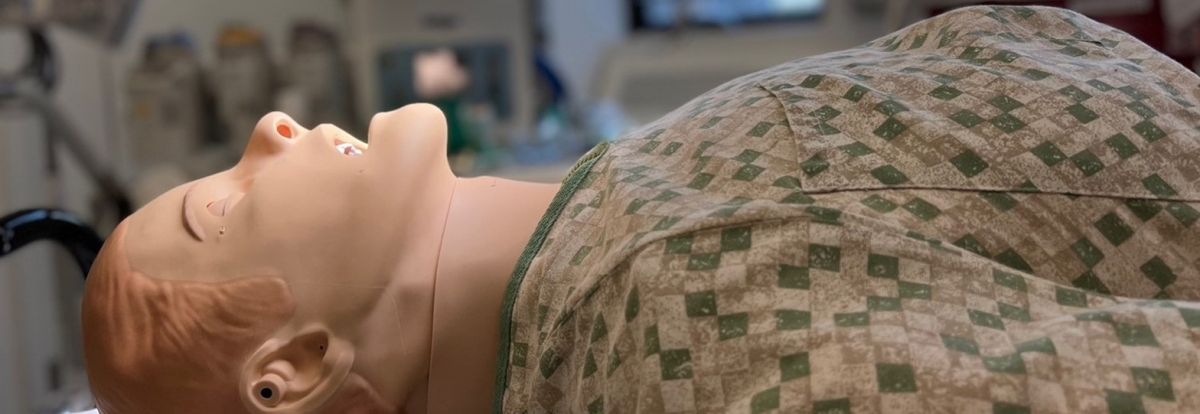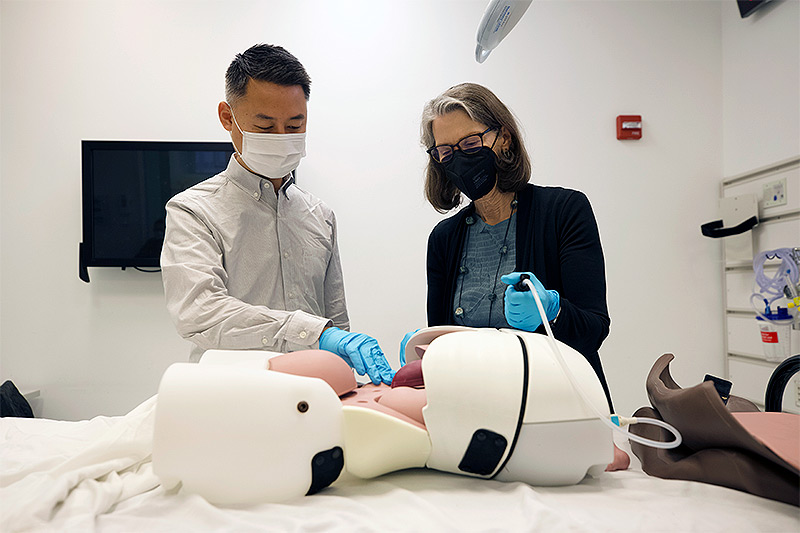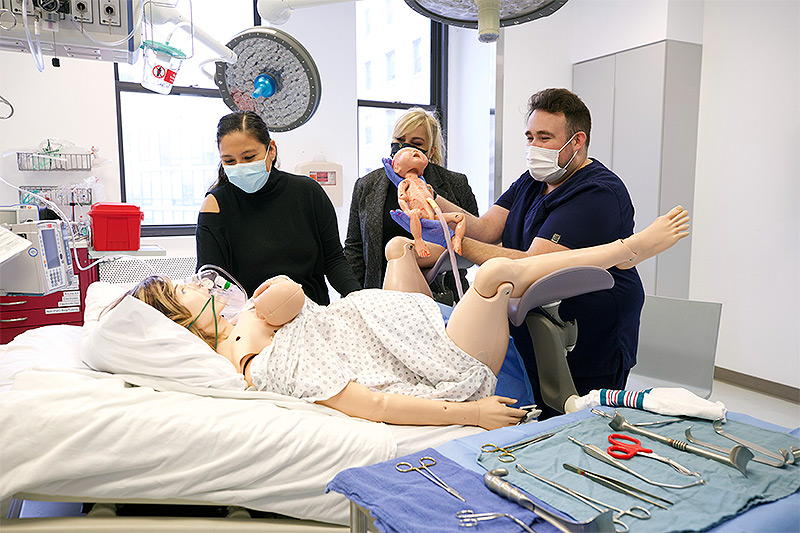Simulation Programs

Simulation Program Overview
The New York Simulation Center for the Health Sciences (NYSIM) offers High Fidelity Simulation services to faculty.
The New York Simulation Center’s Simulation (SIM) Program includes 25 high-fidelity simulators and over 200 partial task trainers. Manikin based simulation activities provide learners with opportunities to practice communication skills, teamwork skills, technical skills, and clinical decision-making skills in a psychologically safe environment that represents various clinical settings. Simulation programs are developed and supported by our experienced simulation team, including the NYSIM Directors, the SIM Program Supervisor, and Simulation Operations Associates (SOAs). Simulated clinical scenarios can be delivered on-site at NYSIM, in-situ in a healthcare setting, or through a remote platform to best serve your educational needs and objectives.
NYSIM’s state of the art facilities include five simulation rooms in the North wing, including two operating room setups, and multi-purpose flex rooms in the West wing, which can accommodate skills stations and complex, high-volume scenarios, such as mass casualty disaster simulations. High-fidelity simulation is an ideal modality for a multitude of your educational objectives and curricular needs.


High fidelity simulators are frequently used by instructors to complement didactic learning, providing a 360-degree educational experience that bridges the gap between the traditional classroom setting and real patient encounters.
Incorporating simulation scenarios into your curriculum enables learners to practice a variety of simple, commonly seen diagnoses, as well as complex patient encounters of rare but lethal diagnoses. Simulation sessions can be run as single scenarios for a few learners or multiple scenarios over the course of a day for many learners. Learners may be involved in direct patient care while others can observe in the simulation room, through a one-way mirror, or watch live streaming in one of our classrooms.
Each learner is assigned a role simulating a real-world healthcare team. Sometimes learners are asked to work one level above their usual role, so they can work more independently. For example, a nursing student may be assigned the role of a newly graduated nurse; a medical student may be assigned the role of an intern; a resident may be assigned the role of an attending physician. Often simulations are utilized for interdisciplinary team building where learners can be physicians, nurses, students, social workers and other healthcare team members to improve communication and collaboration.
The debriefing that follows the scenario is the time to re-emphasize the key learning points. Debriefing can occur in the simulation room or in a separate classroom setting. Each has its own advantages. At the bedside, the teacher can demonstrate skills on the manikin, have the learners retry or role-play through key moments, and “stay in the moment”. A separate debriefing room allows learners time to decompress, provides a change of scenery, as well as access to video playback for review.
To view our full list of manikins, please visit https://nysimcenter.org/manikins.
Faculty Roles
During the simulation scenario, there are several roles for the faculty and instructors to play:
As Scenario Director Behind One-Way Mirror
- Direct flow of the case including transitions (vital signs, critical events)
- Communicate with learners via wireless intercom
- Announce the end of the case and help learners transition to debriefing by entering the room
Instructions on how to control a NYSIM simulation using the Laerdal LLEAP Instructor Application
At the Console
- Control the manikin’s vital signs through the instructor’s computer (the technical support team will train faculty how to use this function)
- Speak for “the patient” through a microphone (manikins include speakers in or near their heads)
As an Actor Embedded in the Scenario
- In the room, make “phone calls” or answer an “incoming call” during a scenario as a way to prompt learners or to answer questions
- Help clarify physical exam findings as needed (skin is warm, there is no pulse, etc.)
- Orient learners as needed
- Communicate and clarify data (whether specific medications were given, etc.)
NYSIM has a variety of partial task trainers available to help you teach your learners in a safe simulation environment. At NYSIM, instructors can also design courses that integrate task trainer learning with computerized patient simulators and standardized participants.
Teaching with partial task trainers has been shown to decrease hospital-acquired infections, length of hospital stays, and healthcare costs. Practicing procedural skills builds confidence in learners and is a safe space to learn before performing procedures on actual patients.
From difficult airway management and central venous catheterization to pelvic exams and ostomy care, NYSIM can help you design a high fidelity simulation program suited for your learners.
The ideal procedure for a partial task trainer course might include the following:
- Pre-course reading and video-based demonstration
- Faculty-led examples and explanations that set the standard for learning
- Careful observation of the learner’s performance, including identification of areas of improvement (formative evaluation)
- Deliberate practice with peer and faculty feedback until mastery is achieved
- Assessment and summary of each learner’s development (summative assessment)
To view our full list of partial task trainers, please visit https://nysimcenter.org/task-trainers.
Learning Remotely Via Online Platforms
At NYSIM, we are excited to offer support for TeleSimulation: a new remote simulation modality using web conferencing technology, coupled with Laerdal manikin vital signs software.
To learn more, watch our 4 minute demo video
In-Person Simulation vs TeleSimulation
| In-Person Simulation | TeleSimulation | |
|---|---|---|
| Location | On site, in person | Learners and instructors remote locations, via Zoom |
| Clinical Decision-Making/Reasoning | Yes | Yes |
| Learner Task Performance | Tasks can be performed physically |
|
| Teamwork Skills | Yes | Yes |
| Communication Skills | Verbal, non-verbal, and physical | Verbal and non-verbal |
| Recommended Learner Group Size | Varies | 4-6 |
| Learner Observation | Yes | Yes |
| Manikin Control | Faculty and program staff | NYSIM Simulation Operations Associate |
| Video Recording | Yes | Yes |
| Video Playback | During debriefing: yes via B-Line After session complete: yes | During debriefing: no After session complete: yes |
| Learner Assessment | Zoom: No B-Line,RedCap, or other select platforms: Yes |
Zoom: No B-Line,RedCap, or other select platforms: Yes |
| Documentation | Yes | Yes |
Interested in hosting a program? Please visit our Program Reservation Instructions page.
Simulation Program Timeline
NYSIM requires 4 weeks advanced notice for new simulation programs
NYSIM recommends 2 weeks advanced notice for recurring simulation programs
Reservation
Placed
Placed
- The program's point of contact submits a Program Reservation Request via the NYSIM website and a hold is placed on the NYSIM calendar.
- Educational Consultation Scheduled (if needed)
Pre-Screen
- Program Supervisor reaches out to point of contact to verify date(s), time(s), and room & equipment availability.
- Alternative dates and times may be requested if there are any conflicts.
Intake
- An intake meeting is required for all new programs and recurring programs once a year.
- NYSIM will coordinate scheduling the intake meeting.
- During this meeting, point of contact will meet with a NYSIM Simulation Operations Associate to discuss the program needs in detail.
Program Confirmed
- After the intake, an email approval for the program will be sent with program details and will be confirmed on the NYSIM calendar.
- Point of contact will share the learner list and content with NYSIM a week prior to the program.
Copyright © 2014 - 2021, NYSIM

